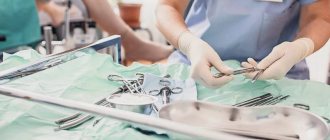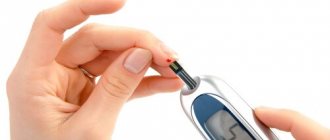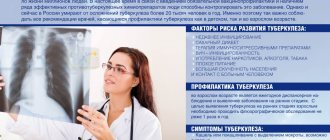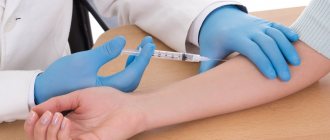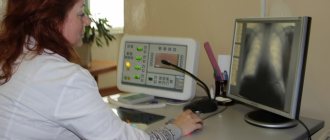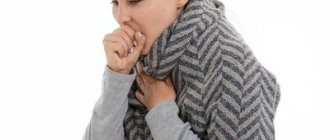Diaskintest® (tuberculosis allergen recombinant in standard dilution) is an innovative intradermal diagnostic test, which is a recombinant protein containing two interconnected antigens - ESAT6 and CFP10, characteristic of pathogenic strains of mycobacterium tuberculosis (Mycobacterium tuberculosis)1. These antigens are absent in the vaccine strain Mycobacterium bovis BCG and in most non-tuberculous mycobacteria, therefore Diaskintest® causes an immune reaction only to Mycobacterium tuberculosis and does not give a reaction associated with BCG vaccination. Thanks to these qualities, Diaskintest® has almost 100% sensitivity and specificity2, minimizing the likelihood of developing false-positive reactions, which are observed in 40–60% of cases when using the traditional intradermal tuberculin test (Mantoux test)3. The technique for performing the Diaskintest and recording the results is identical to the Mantoux test with tuberculin4.
In Russia, the use of Diaskintest was approved in 2009 by Order of the Ministry of Health of the Russian Federation 855 of October 29, 20094
Since 2021, the use of Diaskintest in screening for tuberculosis in children over 7 years of age and adolescents is regulated by Order of the Russian Ministry of Health No. 124n dated March 21, 20215.
Diaskintest is highly sensitive and highly informative: it allows you to exclude false-positive reactions that occur during the Mantoux test in vaccinated individuals (post-vaccination immunity). According to various estimates and in different regions of Russia, the sensitivity of Diaskintest is about 96%.
How does Diaskintest differ from the Mantoux reaction?
Due to the fact that the drug DIASKINTEST contains proteins that cause an immune response only to the presence of pathogenic (capable of causing disease) mycobacterium tuberculosis, the test has a higher sensitivity compared to the Mantoux river (the ability to detect infection in those who actually have it ) and, most importantly, higher specificity (the ability to give a negative reaction in those who do not have an infection).
Mantoux, Diaskintest test, Quantiferon test or T.SPOT? How do the methods for diagnosing tuberculosis differ and which one to choose?
Indications for use of "Diaskintest"
"Diaskintest" is used to conduct an intradermal test in children over 8 years of age, instead of the Mantoux test, for the purpose of diagnosing tuberculosis of exclusively pulmonary localization, assessing the activity of the process and identifying patients at high risk of developing an active tuberculosis process. "Diaskintest" is intended for performing an intradermal test for the following purposes:
- children from high-risk groups for tuberculosis who are not subject to dispensary registration by a phthisiatrician
- to identify patients at high risk of developing active tuberculosis (latent tuberculosis infection)
- for differential diagnosis of post-vaccination (BCG) and infectious allergies (delayed-type hypersensitivity)
- to evaluate the effectiveness of anti-tuberculosis treatment in combination with other methods
- in patients suffering from diabetes mellitus, peptic ulcer disease
- in patients with chronic nonspecific purulent-inflammatory diseases of the bronchopulmonary system and kidneys
- in HIV-infected patients
- in patients receiving long-term immunosuppressive therapy (cytostatics, corticosteroids, genetically engineered biological drugs (GEBP), etc.)
Parent Questions
Is it possible to do Diaskintest if allergies worsen?
Yes, but against the background of desensitizing therapy (5 days before and 2 days after the test).
Is it possible to eat sweets while on Diaskintest?
Can. But if you know that sweets can provoke an exacerbation of skin allergies, then it is better not to give them to your child.
Is it possible to do Diaskintest with a runny nose?
Yes, if it is not accompanied by an increase in temperature.
Is it possible to do Diaskintest immediately after an illness?
You should wait 2-3 days after the temperature has returned to normal. Residual runny nose and cough are not a contraindication and will not affect the results of Diaskintest.
Can Diaskintest provoke tuberculosis?
Preparations for Diaskintest are obtained from genetically modified strains of Escherichia coli, which in no case can cause the development of tuberculosis. Diaskintest is usually very well tolerated, only in rare cases there is a short-term and slight increase in temperature, mild headache and malaise.
Is it possible to wet Diaskintest and is it possible to go to the pool after Diaskintest?
Yes, you can wet Diaskintest and wash yourself. But it is still better to avoid exposure to chemical irritants (shampoos, reagents in the pool). Also try to prevent the child from scratching the sample.
What should a child not do after Diaskintest?
You should not rub or scratch the injection site, or apply any chemicals (iodine, brilliant green, hydrogen peroxide, creams) to it; for the same reason, you should not visit the pool. Everything else (walking, swimming, eating everything that does not cause an allergic reaction in your child) is possible.
What to do if a purple bruise remains after Diaskintest?
Don't worry ahead of time. Firstly, the bruise may completely disappear by the time of the test. Secondly, the size of the bruise also matters. During the test, the doctor will measure your reaction to the test and give you precise instructions on what to do next.
Can there be a fever after Diaskintest?
Yes, elevated temperature after Diaskintest in children is quite possible. Usually the discomfort does not last long and goes away on its own without treatment. What to do if you have a high temperature after Diaskintest? Most likely, it is associated not with the tests being carried out, but with ARVI or another disease that coincided with the time of Diaskintest.
Is it possible to get vaccinated after Diaskintest?
The interval between vaccinations (including BCG) and Diaskintest should be at least 1 month. If the Diaskintest result is negative, you can start vaccination immediately after the test.
Is it possible to do Diaskintest after Mantoux?
Yes, you can do Diaskintest after the Mantoux test.
Is it possible to refuse Diaskintest?
Yes, you can refuse Diaskintest and replace it with other tests for tuberculosis, such as the Mantoux test, quantiferon test or T-spot, as well as fluorography for children 15-17 years old. We do not advise you to refuse tuberculosis tests as such: the epidemic situation in Russia remains tense.
You can always ask all your questions and consult about Diaskintest in your particular case with our pediatricians by phone: +7 812 331 00 00.
The principle of action of the drug "Diaskintest"
The action of the drug "Diaskintest" is based on the detection of a cellular immune response to antigens specific to Mycobacterium tuberculosis. When the drug is administered intradermally in persons with tuberculosis infection, a specific skin reaction occurs, which is a manifestation of delayed-type hypersensitivity.
To identify (diagnosis) tuberculosis infection, a test with Diaskintest is carried out:
- children sent to an anti-tuberculosis institution for additional examination for the presence of a tuberculosis process;
- children belonging to high-risk groups for tuberculosis, taking into account epidemiological, medical and social risk factors;
- children referred to a phthisiatrician based on the results of mass tuberculin diagnostics (Mantoux).
Important! A test with the drug "Diaskintest" cannot be used instead of a tuberculin test (Mantoux) to select individuals for primary vaccination and revaccination with BCG
Evaluation of test results with Diaskintest
The result of the test is assessed by a doctor or trained nurse 72 hours after it was performed by measuring the transverse (relative to the axis of the forearm) size of the hyperemia (redness) and infiltrate (papules) in millimeters with a transparent ruler.
Hyperemia is taken into account only in the absence of infiltration.
The response to the test is considered:
- negative - in the complete absence of infiltration and hyperemia or in the presence of a “puncture reaction” of up to 2 mm;
- doubtful - in the presence of hyperemia without infiltration;
- positive - in the presence of infiltrate (papules) of any size.
Positive reactions conditionally vary in severity:
- mild reaction - in the presence of infiltrate up to 5 mm in size;
- moderate reaction - with an infiltrate size of 5-9 mm;
- pronounced reaction - with an infiltrate size of 10-14 mm;
- hyperergic reaction - with an infiltrate size of 15 mm or more, with vesicular-necrotic changes and (or) lymphangitis, lymphadenitis, regardless of the size of the infiltrate.
Persons with questionable and positive reactions are examined for tuberculosis.
There is usually no reaction to Diaskintest:
- in persons not infected with Mycobacterium tuberculosis;
- in persons previously infected with Mycobacterium tuberculosis with inactive tuberculosis infection;
- in patients with tuberculosis during the period of completion of the involution of tuberculous changes in the absence of clinical, X-ray tomographic, instrumental and laboratory signs of process activity;
- in persons cured of tuberculosis;
- in persons with extrapulmonary localization of tuberculosis.
At the same time, a test with the drug "Diaskintest" may be negative in patients with tuberculosis with severe immunopathological disorders caused by a severe course of the tuberculosis process, in persons in the early stages of infection with Mycobacterium tuberculosis, in the early stages of the tuberculosis process, in persons with concomitant diseases accompanied by an immunodeficiency state.
WHY DO YOU NEED DIASKIN?
Many people confuse Diaskintest with a vaccine. But this is not true at all. There is no point in refusing the test, since up to 95% of adults today are infected with Koch's bacillus. That is, they are carriers of tuberculosis bacteria. This carriage is called the latent form of the disease - when a person is not sick, but the disease can develop under certain conditions. This option is observed in 1% of patients. Moreover, the infectious process can be asymptomatic for a long time. Without testing, it is impossible to identify it only by external signs. And the earlier the tuberculosis process is detected, the higher the patient’s chances of recovery.
Is it possible to be allergic to Diaskintest?
An allergic reaction is an individual manifestation of the activity of the immune system. It is impossible to predict how the immune system will behave when it is “acquainted” with a new drug. The test will not necessarily provoke an allergy, even in a child prone to food allergic reactions. But if this tendency exists, it would not be a bad idea to prepare for the injection.
According to Alexander Ushakov, children with allergies are recommended to start taking an antihistamine five days before the test and continue the course for two more days after it. If severe swelling occurs at the injection site, which obviously corresponds to an allergic reaction to Diaskintest, the course of the antihistamine should be extended, according to the doctor’s recommendation. And in the future, a child with allergies will be prescribed a Mantoux test instead of this test.
How and when the test is carried out
The test is carried out similarly to the Mantoux test after examination by a doctor and exclusion of contraindications. The drug is injected into the forearm in a volume of 0.1 ml intradermally, assessed after 3 days by a doctor.
Our clinic performs Diaskintest, which allows you to clarify the preliminary results of the Mantoux test or is used as an alternative when refusing fluorography or Mantoux.
| Name of service (price list incomplete) | Price, rub.) | In installments* |
| Tuberculin test (Diaskintest) | 1 300 | — |
| Reading the results of a tuberculin test, Diaskintest | 300 | — |
* You can read more about the conditions here - Treatment on credit or in installments.
Possible side effects
For most, the test process is asymptomatic.
Headaches, general weakness, sleep disturbances, and increased body temperature may occur. Individuals with altered reactivity experience allergic reactions. Considering the possibility of developing immediate allergic reactions (anaphylactic shock, Quincke's edema, urticaria) in particularly sensitive individuals, vaccinated persons must be provided with medical supervision for 30 minutes.
Come get vaccinated at MiracleChildren. A full range of vaccines for children and adults, family vaccinations - at a special price!
HOW HIGH PRECISION OF DIASKINTEST IS ACHIEVED
Diaskintest is a diagnostic test based on the formation of a delayed-type hypersensitivity reaction (DHT), manifested in the form of a compaction (papule) at the injection site in the presence in the body of mycobacterium tuberculosis, pathogenic for the human body, with the presence in its structure of two antigens ESAT-6 and CFP-10 . These antigens are not found in vaccine mycobacteria (BCG) and non-tuberculosis bacteria.
If a person is sick with tuberculosis (active or latent (latent) tuberculosis infection), then a compaction (papule) forms at the injection site of Diaskintest - a positive test. In this case, a thorough further examination is necessary to exclude active tuberculosis. In the absence of reliable signs of the disease, a positive test indicates that the person has a latent (latent) tuberculosis infection and there is a high risk of the disease becoming active in the near future. Therefore, special preventive treatment with anti-tuberculosis drugs is necessary.
If a person is healthy and has immunity from tuberculosis after vaccination with BCG (post-vaccination immunity), then the Diaskintest will be negative.
To assess the effectiveness of any test sample, two main characteristics are taken into account: sensitivity and specificity. The higher these indicators, the better the test detects infection.
The sensitivity of the test is the presence of positive reactions in individuals with a reliably confirmed diagnosis.
The sensitivity of Diaskintest is 96.0%6.
The specificity of the test is a negative reaction to the test in absolutely healthy people.
The specificity of Diaskintest is 99.0%6.
All this allowed Diaskintest to become a reliable and highly informative method for diagnosing both latent and active tuberculosis. High diagnostic accuracy allows you to avoid unnecessary and often harmful treatment courses and studies.
Contraindications
Only a doctor can decide whether Diaskintest is suitable for testing for tuberculosis.
The Diaskintest test is not recommended and is not performed on children under 7 years of age inclusive.
"Diaskintest" is contraindicated for persons with allergic and autoimmune diseases! Also, the use of Diaskintest is contraindicated in the following cases:
- Acute diseases or exacerbation of chronic diseases (except for cases of suspected tuberculosis).
- Skin diseases.
- Epilepsy.
- In children's groups where there is a quarantine for childhood infections, the test is carried out only after the quarantine is lifted.
FREQUENCY OF SAMPLE PERFORMANCE
According to the recommendation of the Russian Ministry of Health, Diaskintest must be performed once a year at the age of 8-17 years. When deciding how often you can test, take into account some nuances:
- The test can be done no earlier than a month after any vaccination.
- A month must pass after recovery from any infectious disease.
- If the previous test result was negative, the next test can be done after 2 months.
A control test for people registered at an anti-tuberculosis dispensary is carried out every 3-6 months.
If a child has a positive Mantoux test, he can perform Diaskintest from the age of 1 year.

